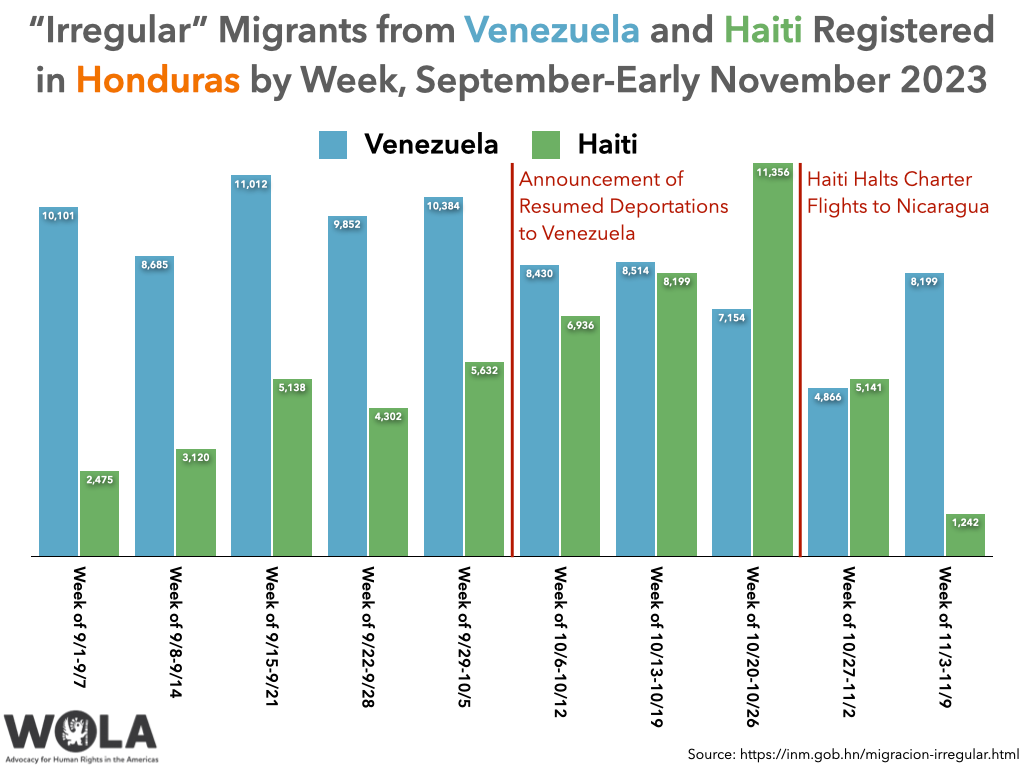Updates from Adam Isacson (November 21, 2023)
Hi, this is Adam. If you're receiving this message, it means you signed up on my website to receive regular updates. If you'd like to stop getting these, just follow the instructions further down.
Consider this one a "double issue." Thursday is a big national holiday in the United States (Thanksgiving), and I will be spending it, and the coming weekend, with family. So no email this coming weekend; I'll aim to post again on the weekend of the 1-2.
I've spent recent days working on reports from my trip to Colombia: one on migration, one on coca and conflict. I'm aiming to keep both of them short (under 4,000 words or so).
I'm a couple of days behind schedule because on the 14th, U.S. Customs and Border Protection (CBP) published its border dataset through October. I hadn't yet incorporated their September data, which they published about 36 hours before I left for Colombia, so there was a lot to update.
I have since done so, and if you go to borderoversight.org and click on "Infographics," you'll now find a handy table of contents to 91 charts and graphics—completely up to date, with a Google Sheet data table for each—about migration trends at the U.S.-Mexico border and along the migration route, as well as drug seizures and other border security measures. (You can also see the whole firehose of infographics, shown with the most recently updated ones first, or download them all in an 8mb PDF file.) Bookmark this resource.
This week's e-mail has links to the border update; a few of those infographics; a WOLA memo about what's happening in Congress; and links to a few recommended articles. No "upcoming events" because there's little happening here in Washington during Thanksgiving week.
U.S.-Mexico Border Update: November 17, 2023
Read the whole update at WOLA's website.
THIS WEEK IN BRIEF:
For the first time since May to June, the number of migrants arriving at the U.S.-Mexico border declined from September to October. The main reason was a drop in migration of citizens of Venezuela, a likely “wait and see” reaction after the Biden administration, on October 5, announced a resumption of deportation flights to Caracas. Other trends included a rise in arrivals of Mexican families and a general westward shift in migrants’ destinations, with Arizona a particular focus.
Migration also declined in Panama’s Darién Gap region in October, led by a drop in Venezuelan citizens transiting the perilous jungle route. Migration through Honduras, however, jumped to over 100,000 people in October. The reason is an increase in aerial routes to Nicaragua, which does not require visas of most countries’ visiting citizens.
The state legislature of Texas, which is dominated by a Republican Party strongly critical of the Biden administration’s border policies, added the latest in a series of hardline measures: a law that would make it a state crime to cross the border irregularly from Mexico. The law raises questions about Mexico’s willingness to take back migrants expelled by Texas, the constitutionality of a state enforcing immigration laws, and a possible increase in racial profiling that today’s more conservative Supreme Court might uphold.
Read the whole update at WOLA's website.
At WOLA: U.S. Congress Must Not Gut the Right to Asylum at a Time of Historic Need

Republican legislators have dug in and have given the Biden administration a list of demands. Aid for Ukraine and other items in the White House’s supplemental budget request will not get their approval, they say, unless the law is changed in ways that all but eliminate the right to seek asylum at the U.S.-Mexico border.
Here, at WOLA’s site, is an analysis of this proposal and the unspeakable harm that it would do. We urge the administration and congressional Democrats to stand strong and reject it.
From the conclusion:
If the Senate Republicans’ November 6 proposal were to become law, it would deny asylum to almost all protection-seeking migrants, unless:That migrant sought asylum and received rejections in every country through which they passed en route to the United States.That migrant presented at a land-border port of entry (official border crossing), even though CBP strictly limits asylum seekers’ access to these facilities.The U.S. government could not send that migrant to a third country to seek asylum there.In an initial “credible fear” interview within days of apprehension, that migrant met a higher screening standard.
If an asylum seeker clears those hurdles, the Republican proposal would require them to await their court hearings in ICE detention—even if they are a parent with children—or while “remaining in Mexico.”
This proposal is extraordinarily radical. Congressional Republicans’ demands to attach it to 2024 spending put the Biden administration in a tough position. It is a terrible choice to have to secure funding for Ukraine and other priorities by ending the United States’ historic role as a country of refuge, breaking international commitments dating back to the years after World War II.
Migration at the U.S.-Mexico Border Dropped 11 Percent from September to October

New CBP data for the U.S.-Mexico border is out through October. Combining migrants who came to ports of entry with migrants whom Border Patrol apprehended between the ports of entry, migration fell from 269,735 people in September to 240,988 in October (-11 percent).
Nearly all of the net reduction is citizens of Venezuela, whose numbers fell -39 percent (66,584 in September to 40,863 in October). The Biden administration’s October 5 announcement of resumed deportation flights to Venezuela probably explains the reduction. News of the resumption may have led some would-be migrants to pause their plans.
This drop will probably be short-lived, unless the Biden administration pursues a massive, costly, cruel, and politically absurd blitz of frequent aerial deportation flights to Caracas. (We see no signs of that happening yet.) As I wrote a couple of days earlier, it is reasonable to expect Venezuelan migration to recover, as conditions in the country remain dire and as Venezuelans considering migration realize that the probability of aerial deportation is slim.
Annual CBP Migrant Encounters at the U.S.-Mexico Border, by Nationality
The U.S. government’s 2023 fiscal year ended on September 30. Here’s a comparison of migration at the U.S.-Mexico border, by migrants’ nationalities, over the past three fiscal years.

From 2021 to 2023,
- The three nationalities that saw the largest aggregate increases in migration:
- Venezuela +217,393
- “Other Countries” not specifically named in CBP’s data releases +155,007
- Colombia +153,334
- The three nationalities that saw the largest percentage increases in migration:
- China +5,303%
- Colombia +2,472%
- Peru +2,268%
- The three nationalities that saw the largest aggregate decreases in migration:
- Honduras -105,638
- Guatemala -62,950
- El Salvador -37,175
- The three nationalities that saw the largest percentage decreases in migration:
- Ukraine -64%
- Brazil -51%
- Romania -49%
Darién Gap Migration Dipped in October
Fresh numbers from Panama show a 35 percent drop, from September to October, in the number of people migrating through the Darién Gap. The main cause was a 41 percent decline in the number of citizens of Venezuela (blue in the chart) who traveled through the treacherous jungle region.

2023 is still—by far—a record-breaking year for Darién Gap migration, though. 458,228 people migrated through the region during the first 10 months of the year, making it certain that the year-end total will surpass 500,000. 294,598 of this year’s migrants (64 percent, blue in the chart) have been Venezuelan.

Data from the United States and Honduras also show sharp drops in migration from Venezuela. The cause appears to be U.S. and Venezuelan governments’ October 5 announcement that they would be renewing deportation flights to Caracas. Though these flights are proving to be relatively infrequent so far, the mere possibility of being sent all the way back to Venezuela seems to have led many Venezuelan citizens considering migration to “wait and see” and delay their plans.
Honduras is the country that reports in-transit migration in the most current manner. Looking at weekly migration through Honduras shows a possible recovery in Venezuelan migration (blue) during the first full week of November. However, a single week’s data don’t necessarily point to a trend. Here is migration of citizens of Venezuela during each week between September 1 and November 9.

The chart also shows citizens of Haiti (green), whose numbers rose then fell during the same period. The recent drop owes to the Haitian government, at strong U.S. suggestion, banning charter flights to Nicaragua at the end of October.
Photo

Links from the Past Week
Graciela Mochkofsky, After Forty Years of Democracy, Argentina Faces a Defining Presidential Runoff (The New Yorker, November 18, 2023)
"For the first time in decades, we are seeing the emergence of politicians who don’t share the consensus around Nunca Más"
Lawrence Hurley, ‘He Didn't Deserve to Die Like This': Supreme Court Decision Leaves Family of a Man Killed at the Border Searching for Justice (NBC News, Friday, November 17, 2023)
An analysis by NBC News found the court has effectively dismantled the ability to file lawsuits against federal officials accused of violating constitutional rights
Miriam Jordan, Border Wall Falls Leave Migrants With Devastating — and Costly — Injuries (The New York Times, Tuesday, November 14, 2023)
Hundreds of migrants have ended up needing extensive treatment in U.S. hospitals after trying to scale barriers along the southern border
Allan Bu, Ocotepeque, Honduras: La Ultima Parada de los Migrantes (Contra Corriente, Tuesday, November 14, 2023)
Small and peaceful border municipalities in Honduras are being impacted by the passage of migrants, in the face of the State's passivity
Jordana Timerman, A Lo Bukele (Cenital, November 14, 2023)
El Salvador's model under scrutiny: security, exportation, authoritarianism and human rights
And Finally




